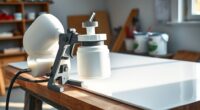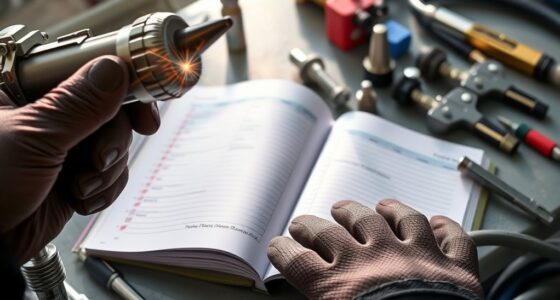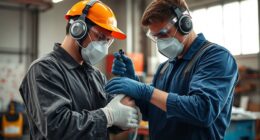If your sprayer is spitting paint, the cause could be clogged nozzles, incorrect pressure settings, or using the wrong tip size. It might also be due to worn or poorly maintained equipment or using incompatible paint or thinners. Tech errors like uneven spray techniques can cause sputtering as well. Fixing these issues involves cleaning nozzles, adjusting pressure, choosing the right tip, and ensuring proper paint prep. Keep going to learn more about troubleshooting and prevention tips.
Key Takeaways
- Regularly clean and inspect the spray nozzle to prevent clogs and ensure smooth paint flow.
- Adjust the fluid pressure to match the recommended settings for your specific spray equipment.
- Use compatible, high-quality paint and properly thin it according to manufacturer instructions.
- Select the correct spray tip size and maintain consistent spraying technique for even coverage.
- Keep equipment well-maintained and store paint properly to avoid blockages and inconsistent spray patterns.
Incorrect Fluid Pressure Settings
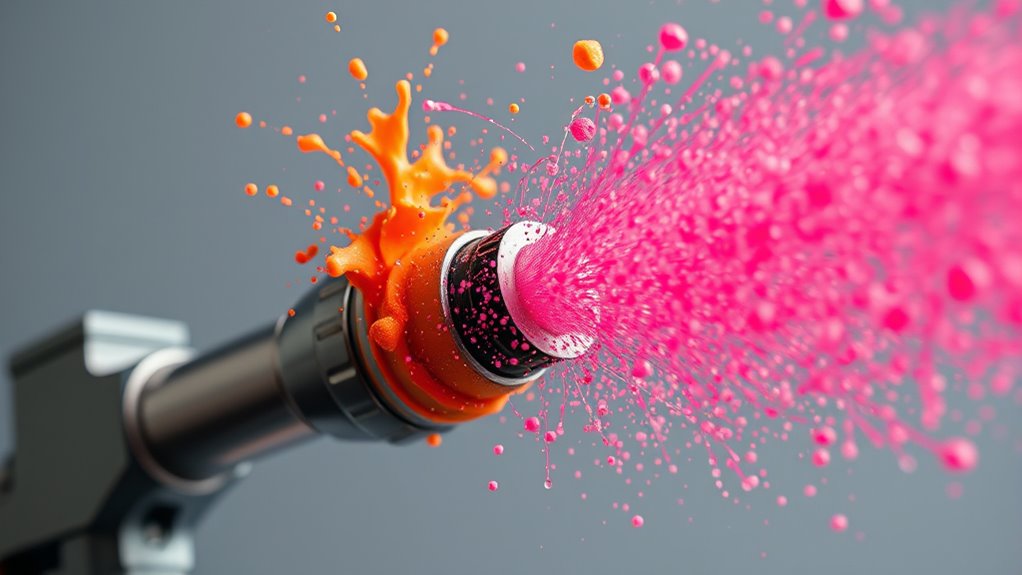
Incorrect fluid pressure settings often cause paint to spit from the sprayer. When your pressure is too high or too low, it disrupts the spray pattern, leading to uneven application and splattering. To fix this, you need to make proper fluid pressure adjustments. Start by testing the pressure on a scrap piece to observe the spray pattern. If the spray is inconsistent or spitting occurs, tweak the pressure accordingly. A balanced pressure ensures a smooth, even spray, enhancing spray pattern consistency. Maintaining the correct fluid pressure not only prevents paint from spitting but also results in a professional-looking finish. Proper sprayer maintenance can help keep your equipment functioning optimally and prevent issues like spitting. Always refer to your sprayer’s manual for recommended pressure settings for different projects and paints, guaranteeing ideal performance and minimal mess.
Clogged or Dirty Nozzle
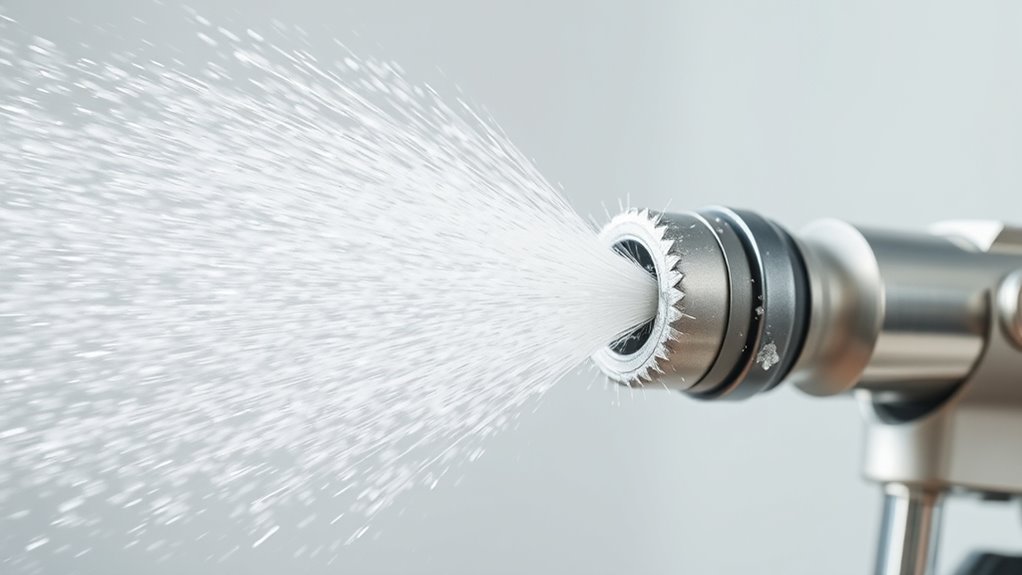
A clogged or dirty nozzle can easily cause paint to spit from the sprayer, disrupting your application process. When the paint nozzle is blocked or has debris, it prevents a smooth, consistent spray pattern. This results in uneven paint flow, leading to sputtering or splattering. To fix this, first turn off your sprayer and relieve pressure. Remove the paint nozzle carefully and clean it with a solvent or warm water, depending on the paint type. Use a small brush or needle to clear any clogs. Make sure the nozzle is completely dry before reattaching. Regularly inspecting and cleaning your spray nozzle ensures a clean spray pattern, reduces spitting, and promotes an even, professional finish. Additionally, understanding projector technology can help improve your setup and prevent issues like uneven spraying.
Improper Spray Tip Selection
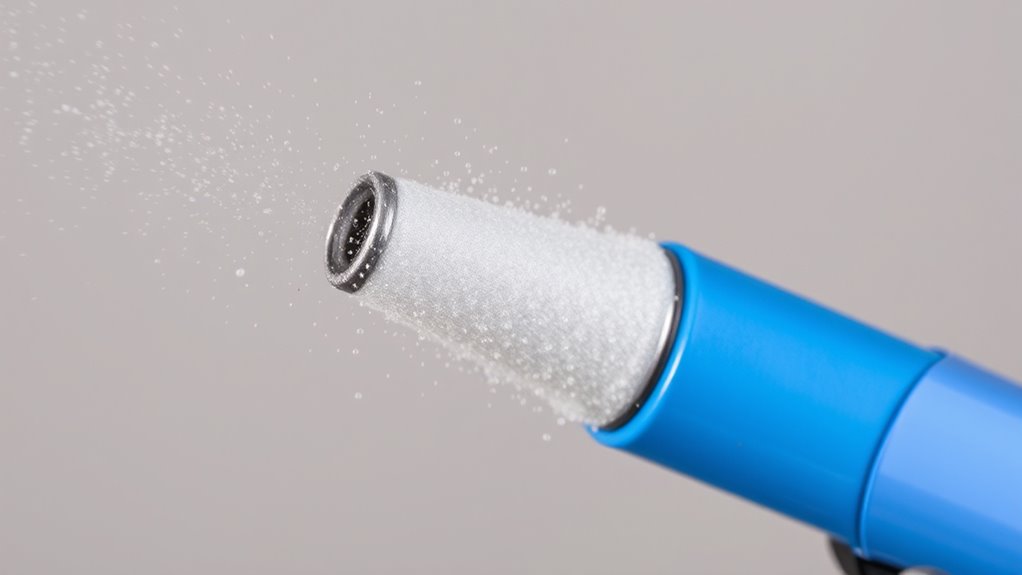
Choosing the right spray tip is vital for achieving a smooth and even paint application. An incorrect tip size or type can cause paint spitting, uneven coverage, or overspray. Make certain your spray tip matches your project needs, considering the material and surface. Regular spray tip maintenance helps prevent clogs and guarantees optimal performance. Additionally, proper nozzle calibration is essential; if your spray tip isn’t calibrated correctly, it can lead to inconsistent flow and spitting issues. Always double-check that you’re using the correct tip and that it’s properly cleaned and maintained before starting your work. Using the right spray tip and maintaining it properly reduces the risk of paint splattering and ensures a professional finish. Proper selection and upkeep are key to a smooth, flawless paint job. Being aware of the spray tip size and type can significantly impact your spraying results and help prevent common issues like spitting.
Poor Equipment Maintenance and Wear
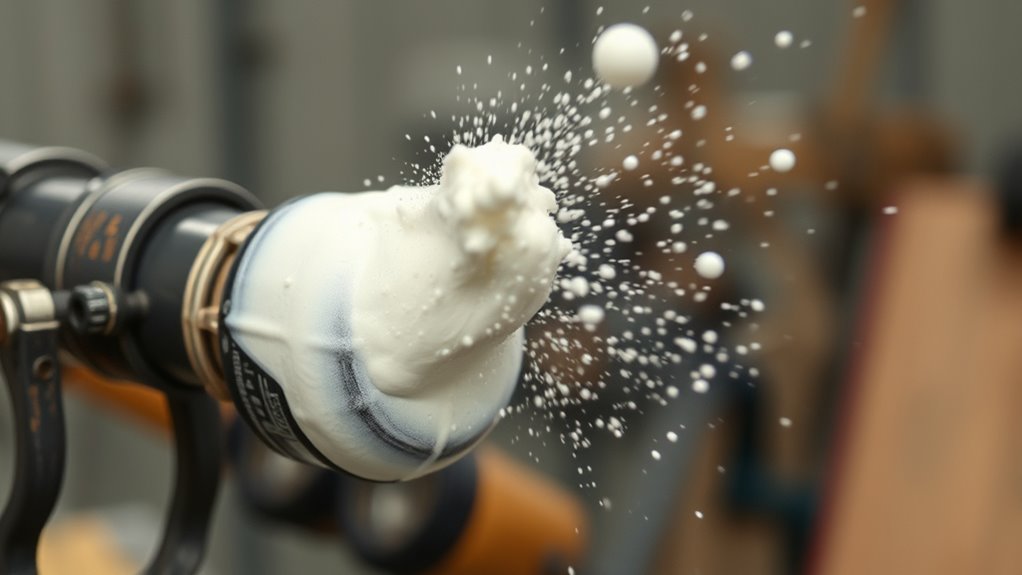
If your sprayer isn’t maintained properly, it can cause paint spitting and uneven application. Regular inspections help catch worn or damaged parts before they cause problems. Make sure to clean your equipment thoroughly and replace parts promptly to keep your sprayer working smoothly. Staying aware of equipment wear and addressing issues early can prevent more serious malfunctions.
Regular Equipment Inspections
Regularly inspecting your spraying equipment is essential to catch issues before they cause paint spitting or other problems. Regular checks ensure equipment calibration stays accurate and identify wear that can affect spray quality. By performing routine inspections, you reduce the risk of inconsistent paint flow and maintain safety precautions. Use this table to guide your inspections:
| Inspection Focus | Key Actions |
|---|---|
| Nozzle Condition | Check for clogs or damage |
| Hoses and Connections | Look for leaks or cracks |
| Equipment Calibration | Verify spray pattern and pressure |
| Wear and Tear | Inspect for worn parts |
| Safety Precautions | Ensure safety guards are in place |
Staying vigilant helps prevent paint spitting and keeps your project on track. Additionally, understanding how AI vulnerabilities can impact equipment safety may inform better maintenance practices.
Proper Cleaning Procedures
Proper cleaning procedures are essential to prevent equipment wear and maintain ideal spray performance. After each use, you should thoroughly clean your spraying tools to avoid buildup and residue. Use appropriate cleaning tools, such as brushes or rags, to effectively remove paint and debris from nozzles, filters, and hoses. Residue removal is critical because leftover paint can harden, clogging components and causing uneven spray patterns. Make sure to flush the equipment with the recommended cleaning solutions, following manufacturer guidelines. Regular cleaning not only extends your equipment’s lifespan but also ensures consistent spray quality. Neglecting this step can lead to wear, leaks, or spitting issues. Incorporating proper cleaning routines can also prevent clogging and buildup, which are common causes of spray problems. By implementing proper cleaning procedures, you keep your sprayer in top condition and prevent common problems caused by poor maintenance.
Timely Part Replacements
Neglecting timely part replacements can lead to increased equipment wear and compromised spray quality. When you ignore signs of worn nozzles, filters, or seals, paint mixing becomes inconsistent, causing splattering or spits. Regularly checking and replacing parts before they fail ensures your sprayer operates smoothly. This proactive approach minimizes downtime and maintains ideal paint atomization. Proper maintenance also helps prevent clogging, uneven application, and uneven spray patterns. By performing timely part replacements, you reduce the risk of paint spitting caused by worn components. Remember, equipment that’s well-maintained performs better and lasts longer. Stay attentive to wear indicators, and don’t delay replacing critical parts to keep your paint mixing precise and your spray quality high. This simple step saves you time and improves your overall results. Preventive maintenance is essential for maintaining consistent spray performance and avoiding costly repairs.
Incorrect Spraying Technique
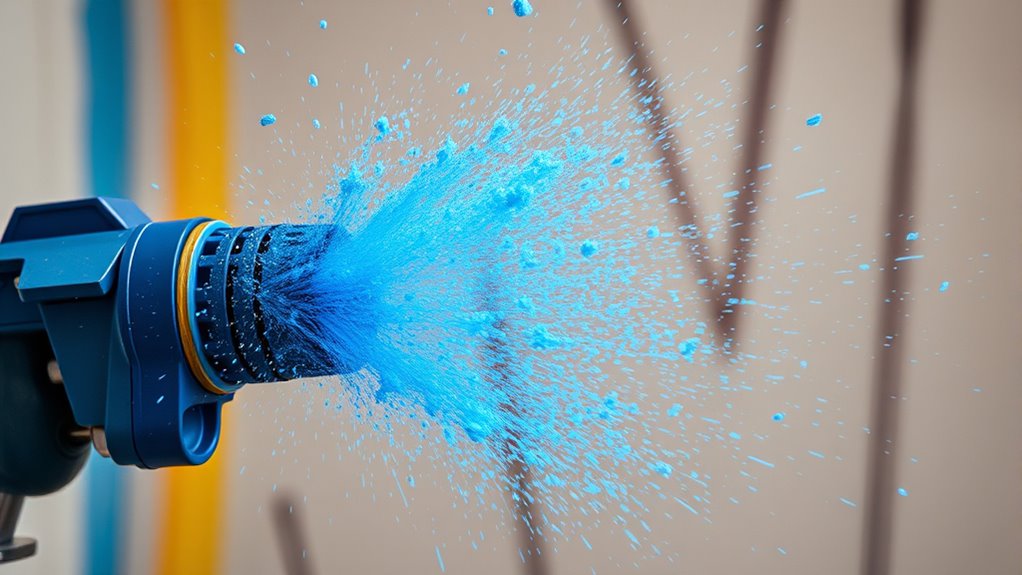
Incorrect spraying techniques are a common cause of paint spitting from the sprayer. If you’re using uneven brush strokes or rushing your application, the paint can splatter and create spits. Proper technique involves maintaining a consistent distance and steady motion, which helps produce a smooth, even coat. Additionally, poor color mixing can lead to inconsistent paint flow, causing irregular spray patterns and spits. Make sure you thoroughly mix your paint before spraying to avoid clogs or uneven distribution. Keep your hand steady and avoid sudden movements, which can disrupt the spray pattern. By refining your technique—focusing on smooth, controlled strokes and well-mixed paint—you’ll reduce the chances of spitting and achieve a professional finish. Consulting proper spraying techniques can further improve your results.
Using the Wrong Type of Paint or Thinner
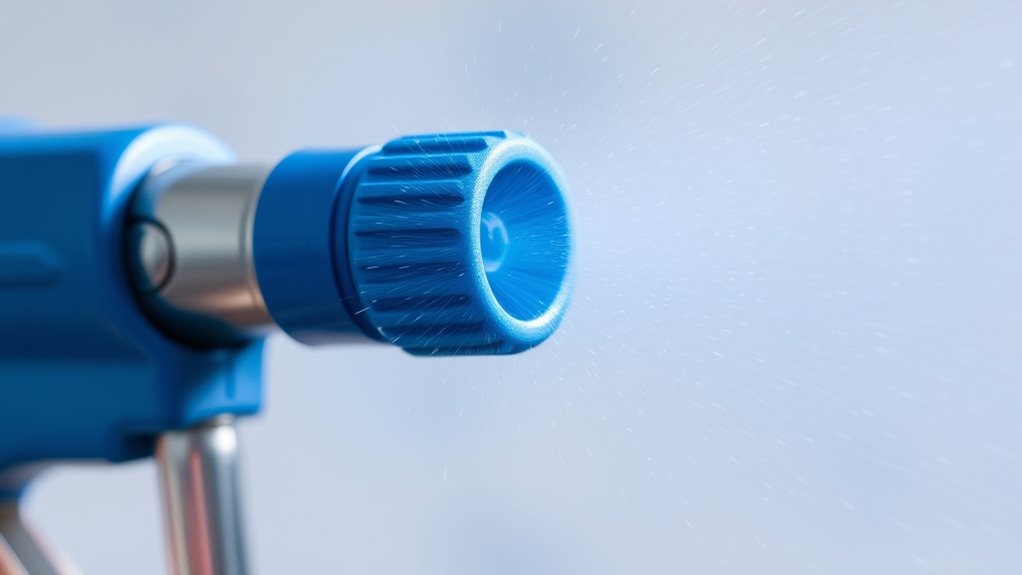
Using the wrong type of paint or thinner can cause your sprayer to spit and clog. If you choose incompatible thinning agents or low-quality paint, it worsens the problem. Picking the right materials is essential for smooth, consistent spraying. Additionally, selecting high-quality products and understanding their industry specifications can prevent equipment issues and ensure optimal performance.
Incorrect Paint Selection
Choosing the wrong type of paint or thinner can cause your sprayer to spit and clog, leading to poor finishes and frustration. Using incompatible paints or neglecting proper color mixing can create inconsistent spray patterns and blockages. Make certain you select the right paint for your sprayer, whether it’s latex, oil-based, or specialty coatings. Proper paint storage is also vital—exposed or expired paint can change in consistency, causing spitting issues. Always stir the paint thoroughly before spraying to maintain uniformity. Avoid using old or improperly stored paint, as it can thicken or separate, making it difficult to spray smoothly. Selecting the correct paint type, mixing colors properly, and storing your paint correctly helps prevent spitting and guarantees a clean, professional finish. Proper preparation and understanding of feature Buddies can also help troubleshoot and prevent spraying issues.
Incompatible Thinning Agents
Selecting the right thinning agent is key to ensuring smooth spraying and a professional finish. Using incompatible thinners can alter the paint consistency, making it too thick or too runny for your sprayer. This often leads to paint spitting or uneven application. Always check that the thinner matches the type of paint you’re using—oil-based paints need specific solvents, while water-based paints require water or compatible additives. In addition, consider nozzle compatibility; some thinners can clog or damage your spray equipment if they aren’t suitable. When in doubt, follow the manufacturer’s recommendations for thinning agents. Properly thinned paint flows smoothly through the nozzle, reducing spitting and ensuring a clean, even coat. Avoid shortcuts—using the correct thinning agent is essential for a professional finish. Additionally, understanding the appropriate paint consistency helps prevent issues like spitting and uneven coverage during spraying.
Poor Paint Quality
Poor paint quality is a common cause of spitting from the sprayer, especially when you’re working with the wrong type of paint or incompatible thinner. Low-quality paints often have inconsistent viscosity, leading to uneven paint consistency that disrupts smooth spraying. If the paint isn’t properly mixed or has dried out, it can cause clogging and sputtering. Additionally, using paint that doesn’t match the required color or formulation can create issues with flow and adhesion. Always check that the paint is fresh, well-mixed, and suited for your sprayer. Proper color matching and consistent viscosity ensure a smooth spray pattern, reducing spitting and achieving a professional finish. Investing in good-quality paint is key to preventing these spraying problems. Selecting reliable paint can help ensure a smoother and more consistent application, minimizing issues like spitting.
Frequently Asked Questions
Can Environmental Conditions Affect Paint Spitting During Spraying?
Environmental conditions definitely impact paint spitting during spraying. Humidity effects can cause paint to atomize unevenly, leading to spitting. High humidity can increase the likelihood of this issue, so you might need to adjust airflow to maintain a steady spray pattern. Making airflow adjustments helps control paint dispersion, ensuring a smoother finish. Always monitor weather conditions and tweak your equipment accordingly to prevent paint spitting caused by environmental factors.
How Does Temperature Impact Spray Gun Performance?
Imagine your spray gun as a delicate dance partner, sensitive to temperature fluctuations that can throw off its rhythm. When temperatures rise or drop unexpectedly, your spray gun’s performance suffers, causing inconsistent spray patterns or spitting. You need to regularly check and calibrate your spray gun to account for these changes, ensuring smooth operation. Proper calibration helps maintain steady paint flow, even as temperature shifts challenge your equipment’s precision.
What Safety Precautions Should I Take When Troubleshooting?
When troubleshooting, you should prioritize safety by wearing protective gear such as gloves, goggles, and masks to prevent exposure to fumes and paint particles. Guarantee proper ventilation safety in your workspace to avoid inhaling harmful fumes and to disperse overspray effectively. Always turn off and unplug the sprayer before inspecting or fixing it, and work in a well-ventilated area to protect your health during maintenance or adjustments.
Are There Specific Brands Better for Reducing Spitting?
When choosing a sprayer, you should look for brands known for better brand compatibility and innovative nozzle design, which can help reduce spitting. Some reputable brands invest in advanced nozzle technology and consistent quality control, making them more reliable. By selecting a brand with proven compatibility with various paint types and well-designed nozzles, you’ll minimize spit issues and achieve smoother, more professional results.
How Often Should I Perform Maintenance on My Spray Equipment?
They say “an ounce of prevention is worth a pound of cure,” and that’s true for your spray equipment. You should perform maintenance regularly, checking equipment calibration and paint viscosity before each project. Clean your sprayer thoroughly after use, and inspect parts for wear. By staying proactive, you’ll keep your sprayer running smoothly, reduce spitting, and assure a flawless finish every time.
Conclusion
To avoid paint spitting from your sprayer, make sure your fluid pressure is correctly set, your nozzle is clean, and you’re using the right spray tip. Regular maintenance and proper technique make a big difference. Did you know that improper pressure settings cause up to 60% of spitting issues? By staying attentive to these factors, you’ll achieve a smoother, cleaner finish every time, saving you time and frustration on your projects.

